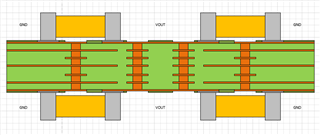Dear TI Team,
We are using TPS548D21RVFT power regulator IC in our new project and it will be used to supply core voltage of main processor on the board(0.8V @ 40A). This is a mass production version of board and we are doing EMI/EMC compliance tests for this board. So by considering this, what and all improvements/ corrections we need to take care in the current design. Also request you to review the attached schematics and provide your feedback.
Best Regards,
Vyshnav Krishnan


